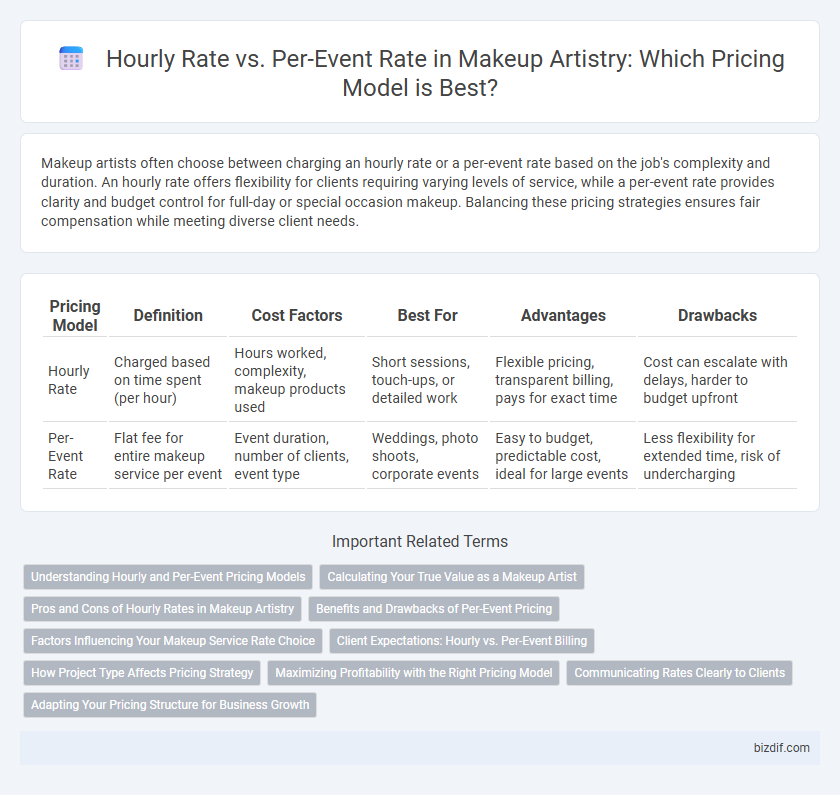Makeup artists often choose between charging an hourly rate or a per-event rate based on the job's complexity and duration. An hourly rate offers flexibility for clients requiring varying levels of service, while a per-event rate provides clarity and budget control for full-day or special occasion makeup. Balancing these pricing strategies ensures fair compensation while meeting diverse client needs.
Table of Comparison
| Pricing Model | Definition | Cost Factors | Best For | Advantages | Drawbacks |
|---|---|---|---|---|---|
| Hourly Rate | Charged based on time spent (per hour) | Hours worked, complexity, makeup products used | Short sessions, touch-ups, or detailed work | Flexible pricing, transparent billing, pays for exact time | Cost can escalate with delays, harder to budget upfront |
| Per-Event Rate | Flat fee for entire makeup service per event | Event duration, number of clients, event type | Weddings, photo shoots, corporate events | Easy to budget, predictable cost, ideal for large events | Less flexibility for extended time, risk of undercharging |
Understanding Hourly and Per-Event Pricing Models
Makeup artists often choose between hourly rates and per-event pricing models to structure their fees effectively. Hourly rates provide flexibility for projects with variable time demands, allowing precise billing based on work duration. Per-event rates offer fixed pricing, ideal for clients seeking budget certainty for single occasions like weddings or photoshoots, often incorporating travel and setup time into the total cost.
Calculating Your True Value as a Makeup Artist
Calculating your true value as a makeup artist involves assessing both hourly rates and per-event rates to match your skill level, experience, and market demand. Hourly rates provide flexibility for varying client needs and project durations, while per-event rates offer predictable income for standard services like weddings or photo shoots. Evaluating factors such as product costs, travel time, complexity, and client expectations ensures your pricing reflects the full scope of your expertise and service quality.
Pros and Cons of Hourly Rates in Makeup Artistry
Hourly rates in makeup artistry provide flexibility, allowing artists to charge accurately for the time invested on complex or evolving looks, which benefits both clients and professionals seeking transparent billing. However, this pricing model can lead to unpredictability for clients, especially if sessions extend longer than expected, potentially causing budget concerns. Makeup artists risk undervaluing their skill during quick applications, as hourly fees might not fully account for expertise and quality, which can make per-event rates more advantageous in some cases.
Benefits and Drawbacks of Per-Event Pricing
Per-event pricing in makeup artistry offers clients clear cost expectations and allows artists to potentially earn more during extensive or multi-hour events, enhancing revenue stability. This pricing model simplifies budgeting for weddings or photoshoots by consolidating fees into a single figure, reducing uncertainty about total costs. However, it may undervalue shorter jobs where the artist's time commitment is minimal, and unexpected delays can decrease profitability, challenging precise time management and fair compensation.
Factors Influencing Your Makeup Service Rate Choice
Choosing between an hourly rate and a per-event rate for makeup services depends on factors like the complexity of the look, client budget, and event duration. Makeup artists handling weddings or special events often prefer per-event pricing to account for preparation, travel, and potential touch-ups. Hourly rates provide flexibility for shorter sessions or trial runs, making it essential to assess client needs and time investment before setting fees.
Client Expectations: Hourly vs. Per-Event Billing
Clients choosing hourly billing for makeup artistry expect transparent pricing that reflects the actual time spent on services, offering flexibility for changes during the appointment. Per-event rates provide a clear, fixed cost tailored to the specific event, helping clients budget confidently without worrying about unexpected time extensions. Understanding these billing methods enables makeup artists to set realistic client expectations and deliver optimal service satisfaction.
How Project Type Affects Pricing Strategy
Makeup artists adjust their pricing strategy based on the project type, with hourly rates commonly applied to shorter, flexible sessions and per-event rates preferred for large, time-intensive occasions such as weddings. Complex projects involving multiple participants or elaborate looks typically warrant flat fees to ensure comprehensive coverage and resource allocation. Understanding the unique demands of each project enables artists to optimize pricing for profitability and client satisfaction.
Maximizing Profitability with the Right Pricing Model
Choosing between an hourly rate and a per-event rate in makeup artistry significantly impacts profitability by aligning pricing with service demand and complexity. Hourly rates offer flexibility for varied tasks, ensuring fair compensation for time-intensive work, while per-event rates provide predictable income for standardized looks and events. Evaluating client needs, event duration, and market standards helps makeup artists select a pricing model that maximizes revenue without undervaluing their skills.
Communicating Rates Clearly to Clients
Clearly communicating makeup artistry rates involves specifying whether fees are charged hourly or per event to avoid client confusion. Hourly rates offer flexibility for varied service durations, while per-event rates provide a fixed cost that can simplify budgeting for clients. Transparent discussions about rate structures promote trust and ensure both parties have aligned expectations.
Adapting Your Pricing Structure for Business Growth
Adjusting your pricing structure by balancing hourly rates and per-event fees optimizes revenue and client satisfaction in makeup artistry. Hourly rates cater to short sessions or touch-ups, while per-event pricing ensures profitability for elaborate occasions like weddings or photo shoots. Evaluating project scope, client expectations, and market trends enables strategic pricing that drives sustainable business growth.
Hourly rate vs Per-event rate Infographic

 bizdif.com
bizdif.com